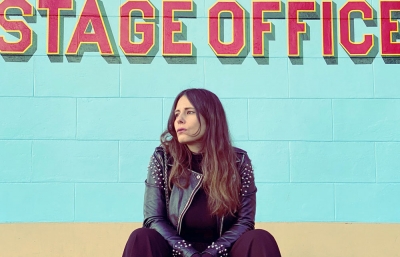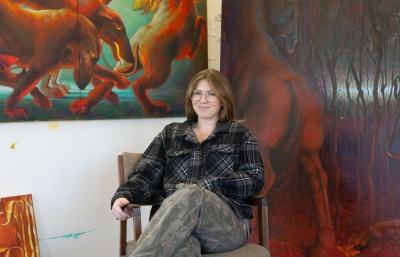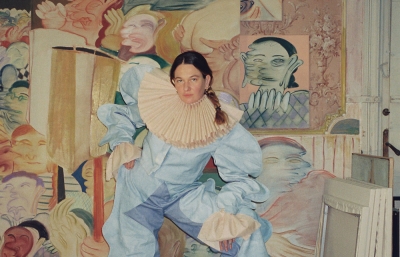Shannon T. Lewis
A Performance of Many Lifetimes
Interview by Shaquille Heath // Portrait by Eric Tschernow
That moment with a Shannon T. Lewis work can feel a bit like a haunting. You may find yourself questioning reality. Wondering if you are present within this world—or another? Shadows of the past emerge, while limbs of tomorrow reconfigure before your eyes. What is seen might be scorched with jolts of terror, maybe bubbling over with pleasure, or something in between. According to Lewis, all are exactly right.
With new representation from Chicago’s Mariane Ibrahim Gallery, Lewis pulls from ghosts all over the world, from her ancestors in Trinidad and Panama, to those on the pages of Vogue magazine. Weaving a wealth of strands, she explores the art of performance—when it is intentional, and when it is second nature. Her use of assemblage honors Black femininity, asserting the Black body with power and vulnerability in spaces too often regulated and structured. It is, in fact, beyond intention.
Lewis is ready to dizzy your head with questions. The answers may not be soothing, but the turbo spin will drive you into asking for more.

Shaquille Heath: Black person to Black person, how are you taking care and where are you finding your joy?
Shannon T. Lewis: This is a good question… I feel like that's what 2020 has been about. Like trying to find these pieces of little simple joys everywhere. And it's been like, a Zoom meetup with friends every week or a watch party. It’s food maybe… I just got back into Toronto and I just had a roti for the first time in, like, a year and a half.
Hell yeah!
[Laughing] Yeah, it’s like all the food of my childhood that I’m about to devour. It’s just the little things. Being able to go for a walk in the summer after being so cooped for a while—that all of a sudden became a special occasion.
You mention being holed up. You were in Berlin, right? What has it been like for you, working through Covid?
The first wave wasn't as bad in Berlin, so there was a little bit of the sense that it was happening somewhere else. But we had to stay home for… maybe two months? Then this summer was weirdly kind of normal. And now it’s back to not-so-normal. Right when I was leaving, everything shut down again.
Were you able to still have access to your studio? Or were you making work in your home space?
I thought that was what I was going to do. I was very ambitious. I brought home some canvases, and I was like–yeah! I’m going to make work during lockdown! And… it just did not happen at all. I couldn't focus. And it also felt like… the world is falling apart. Does it matter if I finish these paintings? kind of thing. And it really took a long time for me to replenish that energy, that creative energy. So, I really didn’t start painting again, I think, until, maybe August. And it took going back to the studio.

Being able to regain that energy, how were you able to channel it again?
I mean, it’s other artists, and looking at their work. Right before we shut down again, I was able to see some really great shows in Berlin. I saw Jenna Gribbon, this painter from New York that I love. I also saw this other show at Gropius Bau. For me, it’s film. It’s also music. It’s reading. I’m really big into fiction. I think a lot of my inspiration kinda comes from, like, Toni Morrison. I read Sula at least once a year. It’s just a spell that I need to stay on this earth. It’s those kinda things. I just read this Helen Oyeyemi book, Boy, Snow, Bird. That was just so incredible. It’s about the breaching of all these different worlds. I’m interested in anything that’s around those topics.
That’s what immediately struck me about your work, these different worlds that you produce. Worlds that exist almost mythically within themselves. Can you talk about that?
It’s about this kind of beautiful monstress for me. That’s really the world we kind of live in, a world mixed with all of these terrors and horrors that underpin everything. But on top of it, there is beauty, there is joy, there is empathy. And, you know, there’s those small moments. And they all kind of mix together to make such a beautiful monster. Or, these otherworldly creatures.
What do you try to explore through your work in showcasing these alternate worlds?
It’s… it’s about fragmentation. I have an immigrant background, and my family’s from Trinidad, though just a little before that, we were from Guyana and from Panama, and all these different places. And I almost feel like I have this line of people who have always been packing a suitcase and are ready to go. There’s kinda this idea about home as a moving target.
As an immigrant, you're so much about performance in the new place that you're in. That’s really what undergirds a lot of my work, as well as the moving between worlds. The moving between classes. The moving between geographies. You behave differently in different places and spaces, and you’re kinda more aware of the performance when you grow up like that. And for me, the fragmentation and the appendages and the arms and the limbs that you gain or you lose, are kinda like an adaptation. A skill that you learn.
And it’s also play! It’s useful and you need it. Sometimes it’s hard work, but sometimes it’s also play.

I love that you call it performance. Hearing that word, you often think of intentionality rather than the performance of necessity.
Yeah, these kind of coded ways that are passed on to you. Or that you pick up and become instinct. Ways you learn, but you didn’t think in terms of learning... but you did! I like to play with these sorts of things, to stop and pause on these moments, and be like, Oh! How did you learn to do that? You know? It’s something that’s always with you. Even when you’re not thinking about it. You don’t turn it off, basically.
I once heard you talk about focusing on what you called the “in-between” moments. What power do you find in the moments of before and after?
I feel like those before and after moments really speak to how much work it was to get to that performance, in a moment. It’s all the lead up. And was it work? Was it a contortion? Was it hard to get to this moment? Or was it pleasure? And you can kind of read that in the before and after.
And then, for me, these moments of before and after, and the work of the performance, speak to these histories, too. Like, what did it take to get here? What did it take to get into this room to perform to you? What happened two generations ago? You know—if my parents didn’t immigrate at a certain time, what would that have done? So it brings all these histories together at this moment.
When you meet somebody, there’s a whole history. Whether that’s colonial history or geographic history, or political history, it all comes to this moment. And the before and after sort of brings these kinds of ghosts, or these traces in.
Being a Black woman, when I was meditating on this, I feel like we, more than most other groups of people, consistently are in this performance mode. And when we step out of these performances, into the “in between moments”—that’s a risk.
Yeah, yeah, precisely. We’re really socialized to be, like, a very specific way. We already kind of understand the regulating structures as Black women, right? You don’t want to appear too angry. You don’t want to appear too aggressive. You have to be strong. So we understand what happens if we slip out of these performances.
I want to talk about these moments because I feel like it’s humanizing. Ya know, [laughing] we’re human beings and we have multifaceted ideas and energies. And what about these other moments? For me, it’s a real celebration for other Black women to read these moments. And to read this slip. And to read the works. It’s a space for, like, play; a safe space for Black women to experience pleasure, intimacy, and this kind of vulnerability that we’re not usually afforded.

Totally. That was a question that I had about these moments—the vulnerability. Was that your intention, or was it maybe just the result of highlighting these moments?
No, for sure, I really want to speak about vulnerability and intimacy. I think, also, vulnerability becomes these moments where we create bonds with one another, just as humans, and social connection. So, vulnerability is an important space, even for internal growth. I want to foster these moments and give them protection and give them a space. Ya know, because we need them.
Are the figures in your works a personal reflection? Or are they reflections of others?
They’re definitely reflections of myself, and aspects of myself, but also of the women around me. My mom, my aunts, my friends. Sometimes I won’t be so aware until I’ve talked about a piece a million times. And then I’m like, oh my god, that was completely about this person…
So they’re definitely real. They’re based on real life and the people around me. But also like, the general Zeitgeist and Black femme culture.
Do you feel like these figures exist in this world, or do they inhabit a realm of their own?
Hmm. I think the thing with them is that they do exist! I think they move between the boundaries of the real, and also the aspirational future world that we hope to live in. And they also live in the past as a kind of connection between all of these. That’s why I think of them… not like ghosts, but as performing the same function as ghosts, in that they tie you to the present, and future, and the past. They’re all of them. And they move between these spaces. That’s what makes them a little bit beautiful—but also a little bit terrifying too. Because you know that’s tapping into something that’s a lot bigger, I think, in their connection to something a lot bigger.
So, in this world, you are indeed an artist. I’m really interested in the moment when you actually realized that.
That’s a good question… I always really liked drawing and painting, which my parents really encouraged. And I had a teacher in high school who said, “Oh! You should go to art school!” And I thought… there are art schools? Like, I never… that was not something that was ever mentioned to me before. Ever since then, I knew that was something I wanted to pursue. I think I got quite lucky that I had probably the only Caribbean parents who were like, “Okay, yeah, go to art school.”

"I want to play with the unconscious archives that people always build up."
I want to talk more about your process. As a collage artist, where do you source your components?
A lot of it is collecting images from magazines. I’m constantly tearing apart Vogue or other fashion magazines, as well as design magazines. It could be things on the internet, but I’m always carrying a catalogue of images. And I’m always kind of cutting them out and playing with them until I find the pieces and the spaces where they belong!
Thinking of an image that I just painted this year, I realized, when I was talking to a friend, that I had actually been carrying around that image for five years. I just didn’t know what I was gonna use it for until the right thing came along. So there’s always this kind of play, and puzzle, and jumble that comes along with it.
I’m curious, what are the questions you want people to ask when they experience your work?
What I really want people to do is to deconstruct their own kind of conclusions. Not necessarily to change them, but to get people to ask why they think the things that they do. It goes back to this idea of the slow-read. I kinda want people to stop and figure out how they've come to develop these sorts of ideas.
I want to play with the unconscious archives that people always build up. We get so many images all the time which attach to certain people, but not others. I want people to sit, stop and examine those archives, then think, “Okay, how did I develop these ideas?” and maybe, “Was I wrong about something? Was I right about something?” It’s not necessarily persuasion, but more about the scrambling. I want people to stop and sort of scramble their convictions a bit.

Well, 2020 was quite the year, and we are talking at the end of it. How do you think this year has changed your art practice, if at all?
Yeah, I think for me, it really made me push and make my work more explicit. I think the thing that has always undergirded my work, no matter how I dress it up, and it's beautiful, is also this idea of the politics underneath. What bodies do we deem worthy to protect? What bodies have access? These are always the questions underneath. But now I feel that I’ve pushed this more to the forefront. Not a question for the back burner, but for Now. Like, who has access to healthcare? Who can stay home? Who can travel? Can you have entry to another country? These are questions that people who have immigrant backgrounds were asking before, but now a lot of us in Western countries are placed in the position for the first time. So, I think I’m pushing these more to the forefront. It’s time to think about it.
All images courtesy the artist and @marianeibrahimgallery






